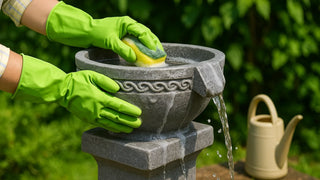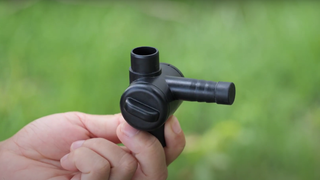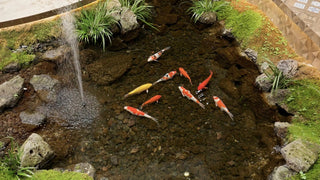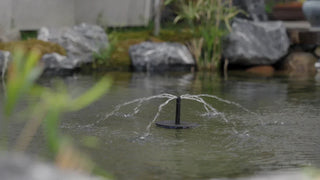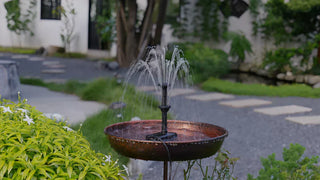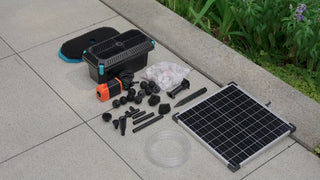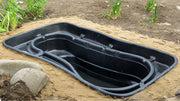
Vous avez choisi une coque de bassin préformée rigide pour une installation rapide et des bords nets. Mais dès que vous ajoutez une pompe de fontaine, un skimmer ou un filtre externe, vous êtes confronté au même défi : percer un trou dans une bâche de bassin préformée pour la plomberie, proprement, en toute sécurité et sans fuite. Bien fait, cela prend moins d'une heure et garantit un débit d'eau sans problème à vie. Mal fait, cela peut fissurer le plastique dur, annuler la garantie de la bâche et vous hanter avec des fuites lentes qui tuent poissons et plantes. Vous trouverez ci-dessous la méthode étape par étape utilisée par les professionnels des jardins aquatiques, ainsi que quelques conseils supplémentaires pour intégrer ce trou à la pompe de fontaine solaire ou au système de filtration de bassin Poposoap, afin que vous n'ayez plus jamais à vous soucier d'une défaillance du joint.
Pourquoi vous pourriez avoir besoin de percer un trou dans une bâche d'étang

- Sorties de pompe et cloisons – Les filtres à cartouche externes et les boîtiers de cascade nécessitent des tubulures de tuyaux étanches à travers la coque.
- Drains de fond – Même les petits étangs ornementaux bénéficient de drains à sédiments qui attirent les débris directement vers un préfiltre.
- Jets de retour – Les raccords directionnels améliorent la circulation, réduisent les points morts et empêchent les nutriments de se déposer.
Si vous souhaitez intégrer une pompe de fontaine solaire Poposoap ou des filtres de bassin, tous deux conçus pour une plomberie « plug-and-play », réaliser une ouverture précise est la première étape vers une union étanche.
Outils et matériaux dont vous aurez besoin

- Marqueur ou ruban de peintre
- Mètre à ruban
- Poinçon central ou poinçon
- Perceuse à vitesse variable et foret de 6 mm (¼ de pouce)
- Scie cloche adaptée au diamètre de la cloison (32 mm, 40 mm, 50 mm sont courants)
- Couteau de loisir à dents fines ou outil d'ébavurage
- Papier de verre humide/sec de grain 120 à 220
- Mastic de revêtement en silicone RTV ou EPDM 100 % sans danger pour les poissons
- Raccord de cloison pour tuyau avec joint(s) et contre-écrou
- En option : pistolet thermique ou sèche-cheveux pour plastique épais et froid
Conseil de pro : achetez une cloison supplémentaire et entraînez-vous à percer sur un morceau de plastique similaire. La confiance vaut bien quelques dollars en pièces détachées.
Étape 1 : Marquez correctement l'emplacement du trou

- Remplissez la coquille avec 5 cm (2 po) d’eau pour la stabiliser dans l’excavation.
- De l'intérieur de l'étang, maintenez la cloison contre le mur par lequel la plomberie sortira.
- Marquez le point central, et non le bord, à travers la gorge du raccord.
- Vérifiez à nouveau l'espace extérieur pour les coudes, les vannes ou le boîtier de filtre de bassin Poposoap que vous prévoyez de monter à côté de l'étang.
Évitez les courbes à la base : la plupart des joints de cloison nécessitent une surface plane pour assurer l'étanchéité.
Étape 2 : percez un trou de guidage

Placez une cale en bois sacrificielle derrière la gaine pour éviter tout arrachement. Démarrez la perceuse en marche arrière pendant quelques secondes pour marquer le plastique, puis passez en marche avant à faible régime. Cela empêche le foret de s'accrocher et de fissurer les coques fragiles en ABS ou en PEHD par temps froid.
Étape 3 : Élargissez l'ouverture avec une scie cloche ou un couteau

Méthode de la scie cloche (idéale pour les revêtements rigides) :
- Placez le foret pilote dans le trou de guidage.
- Faites fonctionner la perceuse à vitesse modérée, en laissant les dents de la scie faire fondre les copeaux plutôt que de les gouger.
- Arrêtez-vous à mi-chemin pour éliminer les débris et empêcher la chaleur de déformer le plastique.
Méthode du couteau (coques fines en fibre de verre) :
- Chauffez légèrement la zone avec un sèche-cheveux jusqu’à ce qu’elle soit chaude, mais pas douce, au toucher.
- Insérez le cutter et marquez autour d'un cercle tracé au compas ; effectuez plusieurs passes légères au lieu d'une seule coupe profonde.
L'une ou l'autre approche doit laisser une ouverture parfaitement ronde, dimensionnée juste assez grande pour le canon fileté de la cloison.
Étape 4 : Lisser et nettoyer les bords

Les bavures acérées entaillent les joints, tandis que les bords irréguliers retiennent la saleté et compromettent l'étanchéité. Utilisez l'outil d'ébavurage ou roulez un morceau de papier de verre dans un tube et polissez le bord coupé jusqu'à ce qu'il soit soyeux. Essuyez la poussière avec de l'alcool isopropylique ou de l'eau claire et laissez sécher.
Étape 5 : Installer le raccord de plomberie avec du mastic

- Poussez le manchon fileté de la cloison du côté humide (à l'intérieur de l'étang) vers l'extérieur.
- Faites glisser le joint en caoutchouc fermement contre la paroi intérieure. Ne prenez jamais deux joints en sandwich ; un seul suffit.
- Appliquez un cordon de 3 mm de silicone sans danger pour les poissons autour de l'épaulement extérieur et sur la face de la doublure.
- Tournez l'écrou de blocage à la main jusqu'à ce qu'il soit serré à la main, puis faites un quart de tour supplémentaire avec une pince tout en maintenant le manchon intérieur fixe.
- Laissez le silicone durcir selon l’étiquette, généralement 24 heures à 20 °C, avant de procéder au test d’étanchéité.
Pourquoi du silicone plutôt que du mastic de plombier ? Le mastic contient des huiles qui s'infiltrent et peuvent troubler l'eau ou endommager les carpes koï sensibles. Les guides d'installation de Poposoap préconisent l'utilisation de silicone à durcissement neutre pour tous les joints plastique-plastique, reflétant ainsi leur philosophie « zéro toxine, sans tracas ».
Bonus : Comment éviter les fissures ou les fuites
- Du plastique chaud les jours froids pour qu'il soit moins cassant.
- Ne serrez jamais trop les cloisons ; les joints comprimés se gonflent et se fissurent avec le temps.
- Soutenez la tuyauterie externe ; un stérilisateur ultraviolet lourd suspendu à une cloison tordra la doublure.
- Installez un coupleur union juste après la cloison : les futurs changements de pompe prennent quelques minutes, pas des heures.
- Associez-le à des préfiltres. Le filtre de bassin Poposoap est doté d'un pré-filtre en acier inoxydable qui bloque les débris avant qu'ils n'obstruent les joints de plomberie, prolongeant ainsi la durée de vie des joints.
FAQ
Q : Puis-je percer le trou une fois que l’étang est rempli d’eau ?
R : Mieux vaut ne pas le faire. Abaissez le niveau d'eau au moins 10 cm sous la ligne de coupe afin que les débris ne tombent pas dans votre système et que les outils restent secs.
Q : Ai-je besoin de mastic supplémentaire des deux côtés ?
R : Une cloison de qualité avec un seul joint intérieur assure une bonne étanchéité ; le silicone à l'extérieur est une assurance de secours.
Q : Que se passe-t-il si je perce mal de quelques millimètres ?
R : Utilisez une scie cloche plus grande et optez pour une cloison de taille supérieure ; la réduction des bagues peut permettre de réduire la profondeur du tuyau. Remplir un trou décentré avec de l'époxy est rarement efficace à long terme.
Q : Les œillets uniseal en caoutchouc sont-ils plus faciles à utiliser ?
R : Ils fonctionnent sur des revêtements EPDM flexibles, mais les coques rigides fléchissent moins et nécessitent une cloison filetée pour résister à la force de gel-dégel.
Q : Combien de temps le sceau durera-t-il ?
R : Correctement installée, une cloison dure 15 à 20 ans, soit la même durée de vie que celle estimée par Poposoap pour ses boîtiers de filtre ABS dans des conditions d'exposition normale aux UV.
Conclusion et appel à l'action

Percer des trous dans la bâche préformée du bassin pour la plomberie peut paraître intimidant ; en pratique, cinq étapes minutieuses et des outils de base permettent d'obtenir une ouverture de qualité industrielle, sans fuite ni fissure. Une fois le trou obturé, fixez une pompe de fontaine solaire Poposoap sur le côté humide ou vissez un boîtier de filtre Poposoap sur le côté sec et profitez d'une circulation silencieuse et économe en énergie, garantie par la promesse « jardin sans souci » de la marque. Votre coque préformée s'intègre désormais parfaitement aux technologies modernes des jeux d'eau, et il ne vous reste plus qu'à couper le ruban le jour de l'ouverture.


